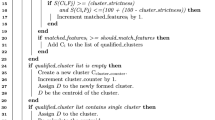Summary
K-means clustering is an efficient non-hierarchical clustering method, which became widely used in data mining. In applying the method, however, one needs to specify k,the number of clusters, a priori. In this short paper, we propose an exploratory procedure for setting k using Euclidean and/or Mahalanobis inter-point distances.
Access this chapter
Tax calculation will be finalised at checkout
Purchases are for personal use only
Preview
Unable to display preview. Download preview PDF.
Similar content being viewed by others
References
Art, D., Gnanadesikan, R., and Kettenring, J. R. (1982). Data-based metrics for cluster analysis, Utilitas Mathematica, 21A, 75–99.
Bensmail, H. and Meulman, J. J. (1998). MCMC inference for modelbased cluster analysis, Advances in Data Science and Classification, edited by Rizzi,A. and Vichi, M., Berlin: Springer.
Campbell, M. A. and Mahon, R. J. (1974). A multivariate study of variation in two species of rock crab of genus Leptograpsus, Australian Journal of Zoology, 22, 417–425.
Everitt, B. S. and Dunn, G. (1991). Applied Multivariate Data Analysis. London: Edward Arnold.
Huh, Myung-Hoe (2000). Double K-means clustering, Unpublished manuscript (Submitted to Korean Journal of Applied Statistics, Written in Korean).
Jin, Seohoon (1999). A Study of the Partitioning Method for Cluster Analysis. Doctoral Thesis, Dept. of Statistics, Korea University. Seoul, Korea.
McLachlan, G. and Basford, K. (1988). Mixture Models: Inference and Applications to Clustering. New York: Macel Dekker.
Milligan, G. W. and Cooper, M. C. (1985). An examination of procedures for determining the number of clusters in a data set, Psychometrika, 50, 159179.
Peck, R., Fisher, L., and Van Ness, J. (1989). Approximate confidence intervals for the number of clusters, Journal of the American Statistical Association, 84, 184–191.
Ripley, R. D. (1996). Pattern Recognition and Neural Networks. Cambridge: Cambridge University Press.
Rost, D. (1995). A simulation study of the weighted -means cluster procedure, Journal of Statistical Computing and Simulation, 53, 51–63.
Sarle, W. S. (1983). Cubic Clustering Criterion, Technical Report A-108. SAS Institute, NC: Cary.
SAS Institute (1990). SAS/STAT User’s Guide (Vol. 1), Version 6 Fourth Edition. SAS Institute, NC: Cary.
Sharma, S. (1996). Applied Multivariate Techniques. New York: Wiley. SPSS Inc. (1997). SPSS 7. 5 Statistical Algorithms. Chicago: SPSS Inc.
Trejos, J., Murillo, A., and Piza, E. (1998). Global stochastic optimization techniques applied to partitioning, Advances in Data Science and Classification, edited by Rizzi, A. and Vichi, M., Berlin: Springer.
Wong, M. A. (1982). A hybrid clustering method for identifying high-density clusters, Journal of the American Statistical Association, 77, 841–847.
Wong, M. A., and Lane, T. (1983). A kth nearest neighbor clustering procedure, Journal of the Royal Statistical Society (Series B), 45, 362–368.
Author information
Authors and Affiliations
Editor information
Editors and Affiliations
Rights and permissions
Copyright information
© 2002 The Institute of Statistical Mathematics
About this paper
Cite this paper
Huh, MH. (2002). Setting the Number of Clusters in K-Means Clustering. In: Baba, Y., Hayter, A.J., Kanefuji, K., Kuriki, S. (eds) Recent Advances in Statistical Research and Data Analysis. Springer, Tokyo. https://doi.org/10.1007/978-4-431-68544-9_5
Download citation
DOI: https://doi.org/10.1007/978-4-431-68544-9_5
Publisher Name: Springer, Tokyo
Print ISBN: 978-4-431-68546-3
Online ISBN: 978-4-431-68544-9
eBook Packages: Springer Book Archive




